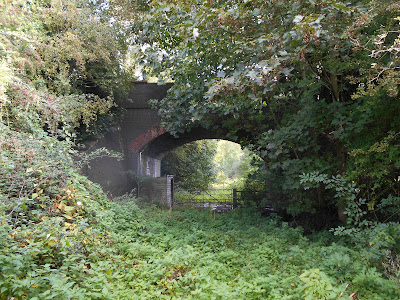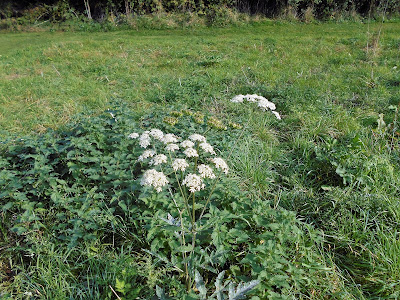 |
| Fraxinus angustifolia beside the A45 in Daventry. 27 Octeober, 2016 |
... to a rich maroon purple.
 |
| Fraxinus angustifolia again, a little further along the road. |
The woodlands of Maine, in the north-east of the U.S.A. are justly famous for their colours in the fall and huge numbers of visitors visit the region to marvel at the sight. Much of the coloration is due to the presence of Acer species - maples and sycamores to you and me - but here in Britain Acers can also take on lovely autumn colours, the intensity of which seems to depend on the weather over the previous two or three months and again, possibly, the soil. Is it my imagination or do trees growing in acid soils develop a brighter red autumn foliage?
The most familiar Acer to most people is the Sycamore, Acer pseudoplatanus. It is probably an introduction but as the pollen is virtually indistinguishable from that of Field Maple there is room for doubt.
 |
Sycamore, Acer pseudoplatanus, beside London Road, Daventry.
26 October, 2016
|
For some reason the autumn colours of Sycamore are, I find, particularly vivid on saplings.
 |
The autumn foliage of a sycamore sapling. Byfield, Northants.
2 November, 2016
|
The Field Maple, Acer campestre, is undoubtedly native. It is a generally smaller tree than the sycamore and its leaves often assume a primrose-yellow hue in autumn.
 |
Young (c. 20 years old) specimens of Field Maple, Acer campestre.
Kentle Wood, Daventry. 27 October, 2016
|
"See me somersault," he cries
diving onto the mattress of dead leaves,
and seeking a womb, he burrows like a mole
among the brittle death-shapes
of oak and sycamore,
then pokes out a face
laughing in resurrection.
'Boy among leaves' from 'Mermaids and Nightingales'
by the late Trevor Hold, 1991
Gradually, as the weeks pass, a task force moves in to work on the breaking-down of this seasonal bounty. There are the larger, obvious invertebrates such as woodlice, millipedes, slugs and snails, but anyone sifting through this material will quickly become aware of the generally smaller springtails. These vitally important creatures are a bit of a taxonomic puzzle: they are obviously arthropods, but just where do they fit in? Should we regard them as an odd group within the insects? That would be convenient but not very satisfactory. As we delve into the leaves they leap around like tiny seashore shrimps - and this is what causes difficulties. Springtails possess an organ called the furca and the unique nature of this mechanism, allowing them to leap for surprisingly long distances, is the problem. How and when did it evolve?
I am embarrassed to admit that, although I have the necessary key to the springtails, I never seem to find the equally necessary time to identify them.
Important though these creatures are, pride of place must go to the minute fungi and bacteria that ultimately return this organic treasure to the soil to form humus. The vital role of these organisms cannot be overstated and we ignore them at our peril. (A recent report by the United Nations Food and Agricultural Organisation predicts that the earth may only have 60 years left for growing crops given the present rate of soil destruction and loss, so soil renewal by processes such as leaf fall are vital.)
Personally, if I investigate dead leaves I am in search of a different group of creatures, the spiders. In the depths of winter, when all seems lifeless, the number of spiders going about their business can be astonishing. Some are active hunters, ever on the move, pausing at intervals to allow the hairs on their legs to detect the slightest movement. These hairs, generally only visible under a microscope, are called trichobothria; they are incredibly sensitive but, from the point of view of an arachnologist, also important in the job of identifying the species in question, particularly with regard to 'money spiders'. Other spiders employ a different strategy, building a simple web and playing the waiting game; for both these groups springtails must form an important prey item.
The carpet formed by autumn leaves is a vital but, as far as I am concerned, under-investigated habitat. I must use the next few weeks to start and remedy this situation.
* Sycamore is generally regarded as an introduction but not all botanists are convinced. For some the jury is still out.















































